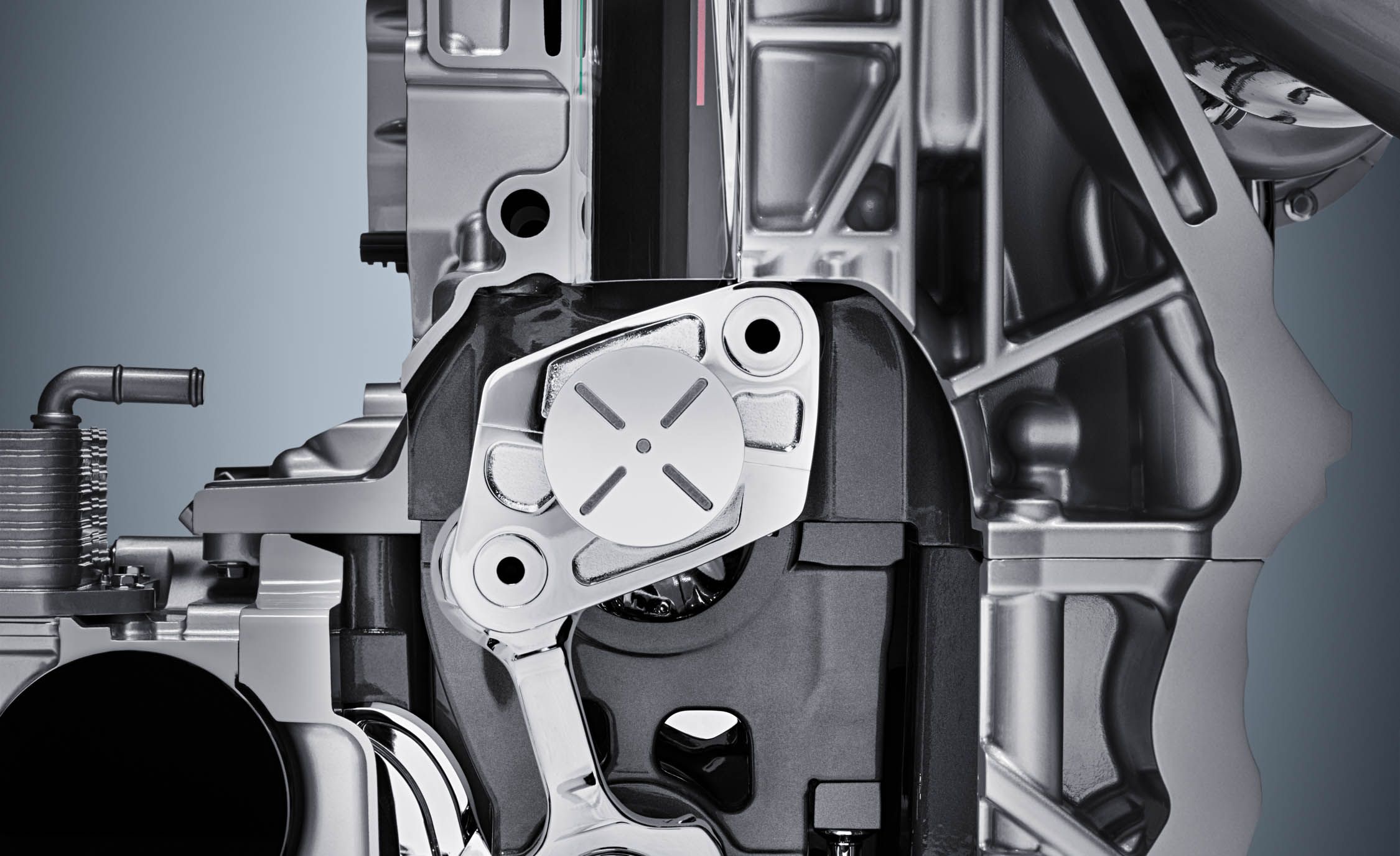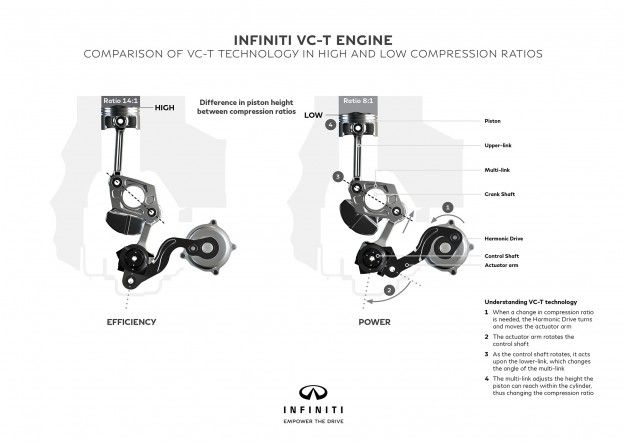
A practical means of varying an engine’s compression ratio has been a goal of automakers for ages. How hard the air—and sometimes fuel—is squeezed before ignition plays a crucial role in overall efficiency. Varying the compression ratio in a running engine is daunting because the ideal ratio changes with speed and load. One expedient now in wide use is combining the Atkinson cycle—which separates the effective compression ratio from the expansion ratio—with variable intake-valve timing. But the current rise in global mileage standards is forcing every maker to search for additional means of curbing fuel consumption.
At this fall’s Paris auto show, Infiniti presented a significant stride in the pursuit of a practical variable-compression-ratio engine, code-named MR20 DDT, and called Variable Compression-Turbocharged (VC-T or VC-Turbo). This boosted 2.0-liter four-cylinder, the product of two decades of research and 300 patents, will first power the next Infiniti QX50 crossover, due in early 2018, before surely spreading across the lineup.

Venturing well beyond the simpler Atkinson-cycle approach, VC-T has four multilink mechanisms inside its crankcase to offer computer control over each cylinder’s compression ratio. The key enabler (labeled “Multi-link” in the illustration above) is a diamond-shaped component that replaces the connecting rod’s big end. When the electronically controlled harmonic drive mechanism rotates, the actuator arm, control shaft, lower link, and finally the multilink all move to vary the piston’s stroke within the cylinder bore. While many automakers have experimented with compound connecting-rod and moving-cylinder mechanisms, Infiniti appears to be the first to solve the durability issues associated with a crankcase stuffed with links and levers, along with three times the typical number of bearings.
Infiniti claims VC-T is capable of providing any desired compression ratio between 8.0:1 and 14.0:1 and that it can switch between those extremes in as quickly as 1.5 seconds. In addition to both port and direct fuel-injection systems, this engine is equipped with individual cylinder ignition timing, variable intake- and exhaust-valve timing, and electronic boost control. It runs on the Atkinson cycle at times. To save weight and cost, the exhaust manifold is integral with the cylinder head, and both the block and head are made of aluminum, but Renault-Nissan global vice president of powertrain and EV engineering, Alain Raposo, admits that this variable-compression 2.0-liter turbo will be roughly 25 pounds heavier than its fixed-compression peers.
Bumping the compression ratio to 14.0:1 during light-throttle cruising maximizes fuel efficiency. Then, when the driver dips into the throttle for passing, the compression ratio can be dropped as turbo boost rises, avoiding detonation while providing the desired performance. Fixed-compression-ratio 2.0-liter turbocharged four-cylinder engines, which have become the go-to powerplants across wide swaths of today’s automotive landscape, generally have a compression ratio in the 9.5:1-to-11.0:1 range, so Infiniti’s VC-T is much higher on the high end and much lower on the low end (lower even than the 8.6:1 compression ratio of the high-performance, 375-hp, 350-lb-ft 2.0-liter turbo four from the Mercedes-AMG CLA45 and GLA45).
Despite that range of adjustability, however, Infiniti is projecting rather modest peak output figures of 268 horsepower and 288 lb-ft of torque. That puts it at the high end of the class, but not at the top, as the 2.0-liter turbo found in Cadillac’s ATS makes 272 horsepower and 295 lb-ft, although we hope the VC-T engine will be less peaky and more refined than the ATS’s.
Speaking of refinement, Infiniti claims that the new engine produces just a third of an inline-four’s typical level of vibration, which means the VC-T doesn’t require the addition of balance shafts. This increase in smoothness is achieved by the fact that the VC-T’s connecting rods remain more upright throughout their stroke, due to the new and optimized geometry created by the arrangement of the extra compression-ratio-adjusting pieces. This reduction in side-to-side motion of the connecting rod also contributes to a substantial decrease in the friction between the piston and the cylinder wall, so much so that it, along with the removal of balance shafts, more than compensates for the added friction from all of the VC-T’s extra moving parts, according to chief engineer Shinichi Kiga.
Efficiency should be one of the most impressive things about this breakthrough engine, but Infiniti has yet to release any mileage figures; Kiga says the target efficiency gain is 10 percent better than today’s 2.0T. His boss, Raposo, adds that this engine “is the first baby of a very large family.” When we speculate about future VC-T engines with more cylinders, he slowly answers “maybe” after flashing a large smirk. But he spoke more openly about the fact that Infiniti is working to integrate additional technologies into the VC-T engine, such as homogeneous charge compression ignition (HCCI) combustion. The ability to vary compression ratio helps to manage that finicky-but-efficient strategy where, as with a diesel, the fuel is ignited by the rising pressure in the cylinder during the compression stroke, rather than by a spark plug, but the fuel remains equally mixed throughout the combusting air, as with a traditional gasoline engine.
Thanks to timely breakthroughs—electronic controls 60 years ago, variable valve timing in the 1980s, and now Infiniti’s combination of electronics and mechanics to vary the compression ratio—there’s no apparent end in sight for the internal-combustion engine.





